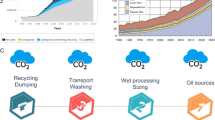Abstract
Purpose
This paper is the second part of a two-paper series dealing with the sustainability evaluation of a new communicative packaging concept. The communicative packaging concept includes a device that allows changing the expiry date of the product as function of temperature during transport and storage: a flexible best-before-date (FBBD). Such device was analysed in a consumer unit consisting of a nanoclay-based polylactic acid tray filled with pork chops.
Methods
An economic assessment was made through the use of life cycle costing (LCC) methodology proposed by Bovea and Vidal (Resources, Conservation and Recycling Volume 41, Issue 2, May 2004, Pages 133–145) where both internal and external costs were considered. Furthermore, the social aspects were analysed using a contingent valuation (CV) of the willingness to pay (WTP). The sustainability assessment of FBBD was made through the combination of life cycle assessment (LCA) and LCC results, together with the CV of the WTP according to the method proposed by Bovea and Vidal. It was assumed that the use of the FBBD minimizes the food losses from 3.5% to 0.5%.
Results and discussion
LCC results show that internal costs related to pork chops and logistic supply chain life cycle represent more than 90% of life cycle cost. The use of FBBD communicative device could increase pork chop selling price between 0.01 and 0.1 € since the purchasing cost of this communicative device is included in this price. WTP results show that FBBD purchasing cost for consumer acceptance is estimated as 0.05 €/FBBD. Therefore, only pork chop selling price for scenarios 1 (0.05 €/device) and 3 (0.01 €/device) could be accepted by consumers. The most sustainable situation is reached when the cost of the FBBD is as less as possible (0.01 €).
Conclusions
The use of FBBD communicative device has economic advantages for perishable products since it contributes to the increase in the economic savings due to the reduction of food losses. However, these economic savings represent a small percentage over pork chop selling price, and therefore, an FBBD price less than 0.02 €/device is required. If a lower price for the communicative device is reached, satisfying the WTP of consumers (0.05 €/FBBD), the communicative package will be much more sustainable.
Recommendations
It is expected that the competitiveness of FBBD communicative device will be improved in the future. This might be accomplished by reducing FBBD production and distribution costs and increasing their social acceptance, providing more sustainable solutions.





Similar content being viewed by others
Notes
European market prices for pork have reference to cost market prices of slaughtered pig carcasses.
According to Dutch new legislation on packaging waste (Nedvang 2007), companies that bring packaging to the market must pay a fixed fee for all packaging. Furthermore, business that place on the market 15,000 kg or more of consumer packaging and plastic drink packaging without deposit must pay a variable fee in addition to the fixed fee.
Transport costs from raw material manufacturer to packaging processor were not included in this cost since they were estimated separately.
Scenarios 1, 3, and 4.
For EC calculation arising from emissions, only several well-known substances were accounted (CO2, CO, CH4, SO2, NOx, N2O and particulates).
The external cost related to noise was calculated through the accounting of the equivalent distance covered by each consumer unit during all transport operations.
References
Antvorskov H (2007) Results of consumer acceptance studies. Deliverable 6.39 of SustainPack Project
Bovea MD, Vidal R (2004) Increasing product value by integrating environmental impact, costs and customer valuation. Resour Conserv Recycl 41(2): 133–145
Craighill AL, Powell JC (1996) Lifecycle assessment and economic evaluation of recycling: a case study. Resour Conserv Recy 17:75–76
Dobon A, Cordero P, Kreft F, Ostergaard SR, Robertsson M, Smolander M, Hortal M (2011) The sustainability of communicative packaging concepts in the food supply chain. A case study: part 1. Life cycle assessment. Int J Life Cycle Assess 16(2):168–177
European Commission (2007) Competitiveness of the European Food Industry. An economic and legal assessment
Isaksson R (2005) Economic sustainability and the cost of poor quality. Corp Soc Respons Environ Manage 12(4):197–209
Kloepffer W (2008) Life cycle sustainability assessment of products. Int J Life Cycle Assess 13(2):89–94
Kreft F, Zayas JL, Hector KB, van der Heijden C, Dobon A, Ostergaard S, Hortal M, Aucejo S, Wienk I (2006) Set up of case study, consumer acceptance studies and LCC analysis. Deliverable 6.38 of SustainPack Project
Kreft F, Wienk I, Hortal M, Zayas JL, Dobón A, Aucejo S (2005) Requirements of communicative packaging concepts. Deliverable 6.13 of SustainPack Project
Maxwell D, van der Vorst R (2003) Developing sustainable products and services. J Clean Prod 11:883–895
Nedvang (2007) Dutch packaging decree. http://english.nedvang.nl/Packaging_Degree. Accessed December 2007
Quinet E (1996) The Social Costs of Transport: Evaluation and Links with Internalisation Policies. In Internalising the Social Costs of Transport, Chapter 2, OECD - European Conference of Ministers of Transport (ECMT), Paris, 1994, pp. 31–75
Robertsson M (2008) Printed electronics, displays and sensors for communicative packaging. 3rd Sustainpack Conference. 6 May 2008, Prague, Czech Republic
Schmidt W-P (2006) Life cycle tools within Ford of Europe’s product sustainability index. Case study Ford S-MAX & Ford Galaxy. Int J Life Cycle Assess 11(5):315–322
Tukker A (2004) Eight types of product–service system: eight ways to sustainability? Experiences from SusProNet. Bus Strategy Environ 13:246–260
van der Heijden C, Wienk I, Kreft F (2007) Report on second simulation model that predicts the feasibility of communicative packaging concepts. Deliverable 6.26. SustainPack. Project
Acknowledgements
This work has been financed by the European Union integrated project: SUSTAINPACK FP6-2002-NMP-1 IP 500311-2.
Author information
Authors and Affiliations
Corresponding author
Additional information
Responsible editor: Hans-Jürgen Garvens
Rights and permissions
About this article
Cite this article
Dobon, A., Cordero, P., Kreft, F. et al. The sustainability of communicative packaging concepts in the food supply chain. A case study: part 2. Life cycle costing and sustainability assessment. Int J Life Cycle Assess 16, 537–547 (2011). https://doi.org/10.1007/s11367-011-0291-9
Received:
Accepted:
Published:
Issue Date:
DOI: https://doi.org/10.1007/s11367-011-0291-9




